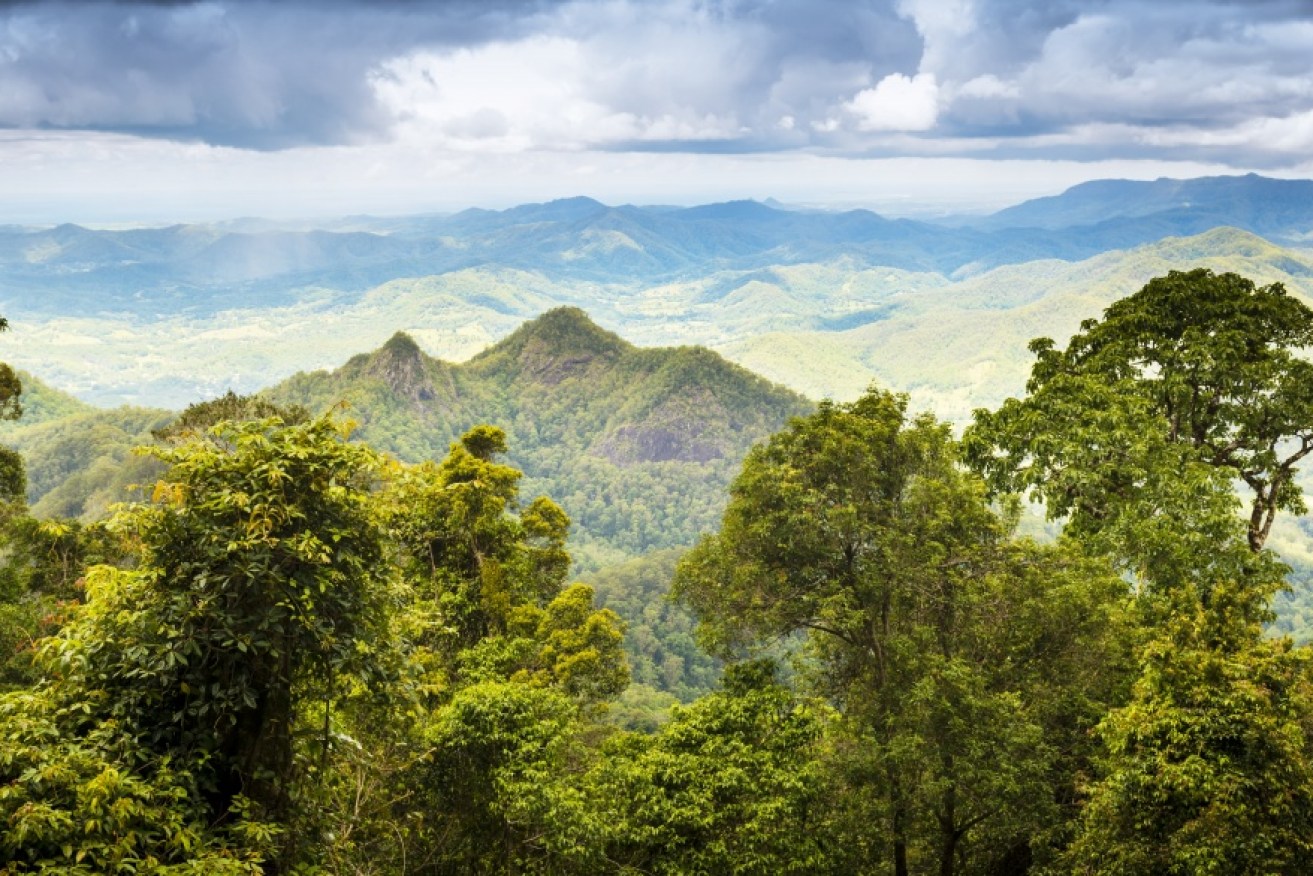Is this Australia’s most surprising wild walk?


Queensland rainforest, as seen from Mount Warning. Photo: Shutterstock
In a new guide to the world’s epic walks, Lonely Planet finds one of Australia’s wildest wanders behind the Gold Coast’s high rises.
Indiana Jones and the Gold Coast
Encounter fascinating wildlife, waterfalls and ancient rainforest on this three-day walk through two national parks in southern Queensland.
A glossy blue-black bird is assiduously arranging the scenery of its performance space. Blue petals and bottle tops are placed centre stage and anything that isn’t blue is briskly flicked aside.
This remarkable scene, starring a satin bowerbird, is happening metres from where I’m staying at O’Reilly’s Rainforest Retreat in Lamington National Park, which is two hours’ drive inland from Brisbane in the volcanic and forested region of the Gold Coast hinterland.
The park, a Unesco World Heritage site, sits on a plateau about 1.5 kilmoetres above the coast and contains a portion of the world’s largest stand of sub-tropical rainforest.
More than 900 plant species, 200 bird species and 60 mammal species thrive up here, alongside 100 species of reptiles and amphibians.
“Many specialised plants and animals only live here,” says park ranger Kerri Brannon. “It’s all about the altitude.”
Lamington National Park is also the starting point for the 54-kilometre Gold Coast Hinterland Great Walk, which descends through dense rainforest, airy eucalyptus woodlands and even grasslands to Springbrook National Park on Queensland’s border with New South Wales.

The 54-kilometre walk. Image: Lonely Planet
Lamington’s altitude has another effect: no matter how steamy it is on the Gold Coast, it will be 50 per cent cooler in the mountains, which makes for comfortable walking conditions in Australia’s late summer.
Pulling on my boots outside O’Reilly’s Rainforest Retreat at the trailhead (you can walk from east to west instead, but you’d be going uphill for most of the way), the sun had yet to warm the chilly mountain air.
Filaments of mist filter through the vines and around the buttressed tree roots; if it seems primeval, that’s because it is. The forests date back hundreds of millions of years and were part of the ancient continent of Gondwana, before Australia broke apart from Antarctica and South America, and ancient species such as cycads (which can be 500 years old), Antarctic beech and hoop pine were once dinosaur food.
On day one we follow the Border Track from the Green Mountains side of Lamington to Binna Burra, where another lodge has cabins and space for camping. This 21-kilometre section is the highest stage of the walk, with views to Mount Warning, the first place in Australia to get sunlight every morning.
My first wildlife encounter on leaving O’Reilly’s is with a gaggle of unperturbed brush-turkeys.
But unless you have sharp eyes or the patience to stand silently, your encounters with birdlife tend to be audio rather than visual. This makes the birds easier to identify. Does it sound like the crack of a whip? That’s a whipbird. Does it sound like a mewling cat? That’s a catbird. A rifleshot? That’s a Paradise riflebird. You get the idea. And if you hear a car alarm or mobile phone, that’ll be an Albert’s lyrebird, an elusive but accomplished mimic.

Keep your ears peeled for the call of the Eastern whipbird. Photo: Shutterstock
At the junction of the Border Track with the Coomera Falls circuit I take the Coomera turning, where I meet Rusty and Nev, two park rangers attending to one of the regular rainy season land slips.
“Some parts of the trail date back to the Depression labour of the 1930s and the 1940s, when unemployed men, and war veterans who found it hard to adapt to civilian life, went into the woods to adjust to life,” explains Rusty.
“They’d fill backpacks with rocks from the creek and carry them along the trails. It was hard, dangerous work – there were no safety harnesses in those days.”
Snakes were a hazard too, and it’s a little later that I encounter Australia’s third-most venomous reptile, a young male tiger snake warming himself on the trail.
The natural history lesson continues on the second section of the walk, which connects Lamington National Park with its eastern relative Springbrook. An intense fragrance in the air turns out to be patch of lemon-scented teatrees. A lattice of roots around a tree trunk is a strangler fig, imperceptibly killing its host over decades.
And then my second Indiana Jones moment occurs: strung across the path, one after another, are spider webs three metres wide at head height, each patrolled by a golden orb spider the breadth of my hand.
No sooner do we reach the valley floor than we start on the steep climb up to Springbrook National Park. Michael Hall, who has been a park ranger for 30 years and is the ranger in charge of Springbrook, explains that people have had as much influence on the landscapes of the Great Walk as volcanic power.
“Aboriginal people,” he says, “burned the woods to create open spaces for hunting, leaving forest for shelter.”
Controlled burning is a tool for defending the fragile eucalyptus forests from encroachment by voracious rainforest plants. Once fire has cleared a space, it’s a starting gun for new life to race upwards to the light.
“Some forest likes a light burn every 10 years,” says Hall, “other forest prefers a crowning fire up to the canopy of the trees every 100 years. A crowning fire can produce 100,000 megawatts of heat per metre.”
Michael is pointing out more plants and trees on the final day’s route past Purling Brook Falls, Springbrook’s 100-metre waterfall, when his eye is caught by a movement on a branch above us.
After three days of prehistoric plants, ancient landscapes and deadly wildlife, he’s spied one more little brown bird. “It’s a spotted pardalote,” he whispers. “I haven’t seen one of those for 20 years. Now that is special.”
–Robin Barton
Catch some nightlife
The wildlife-watching doesn’t end at nightfall. Wherever you’re staying at Lamington National Park, bring a powerful torch and shine it into the trees. Pairs of bright eyes will reflect back at you. They will commonly belong to ringtail or brushtail possums.
You might also spot gliders (sugar or squirrel) in the trees. And more than 20 species of bat flutter around the park.
Orientation
Start: Lamington National Park
End: Springbrook National Park
Distance: 54 kilometres
Getting there: Several tour operators provide transfers from Brisbane airport to O’Reilly’s lodge. From the end of the walk at Springbrook National Park, there are also transfers to Gold Coast airport (closer than Brisbane)
Where to stay: Accommodation is available along the walk, including at O’Reilly’s Rainforest Retreat and Binna Burra Mountain Lodge. Camping permits are required for camping in Queensland’s National Parks
When to go: Winter (June-August) is best
What to take: Sturdy boots, a first-aid kit (and know what to do with a snake bite), water, hat, sunscreen, warm clothing, waterproof jacket, food and camping equipment if needed
More information: Queensland Government Parks & Forests
More like this
Wildlife walks in Oceania

Near the end of the walk, Hanson Bay has clear seas and bright white sand. Photo: Getty
Kangaroo Island Wilderness Trail, South Australia
Opened in late 2016, this five-day hike takes in the raw western edges of Australia’s second-largest island. It’s an area protected as Flinders Chase National Park, and four dedicated campsites have been built along the trail, all with tent platforms and cooking shelters.
As the island’s name suggests, it’s a place prolific in wildlife – koalas, seals, platypus and the eponymous kangaroos. But the most striking feature of the trail is the landscape, from the pounding Southern Ocean seen from atop ragged cliffs to the island’s emblematic Remarkable Rocks (passed on the third day of the trail), a collection of granite boulders that have been scoured by wind into strange and fragile-looking shapes.
A day on, you can duck down to the strikingly clear seas of Hanson Bay before finishing the hike at the limestone Kelly Hill Caves – how many other hikes can you finish with an underground tour?
Start: Flinders Chase Visitor Centre
End: Kelly Hill Caves
Distance: 61 kilometres
More information: National Parks SA

Start the Thorsborne Trail at Ramsay Bay. Photo: Getty
Thorsborne Trail, Hinchinbrook Island, Queensland
Off the north coast of Queensland, Hinchinbrook Island is part of an important marine nature reserve, encircled by mangroves, dugong, green sea turtles, snubfin dolphins and the occasional estuarine crocodile.
The Thorsborne Trail stretches along the east coast and offers challenging, unsanitised but extremely rewarding hiking along empty beaches and through tropical rainforest with some wonderful wildlife viewing opportunities.
Hundreds of species of birds live on or visit the island, from kingfishers and cockatoos to honeyeaters and doves. Reptiles range from pythons to monitor lizards. Hinchinbrook’s plant life is especially important, with many rare species existing on the island.
Hiker numbers are strictly limited so advance booking is essential; April to September are the best months and the walk takes a minimum of four days (three nights) due to the terrain.
Start: Ramsay Bay
End: George Point (or the reverse)
Distance: 32 kilometres
More information: Queensland Government Parks & Forests

The dramatic landscape of New Zealand’s Rakiura National Park. Photo: Getty
Rakiura Track, Stewart Island, New Zealand
Stewart Island’s kiwis – the southern brown kiwi – are extra-large. But that doesn’t mean that they’re any easier to spot. You’ll have to wait until dusk then head for Ocean Beach in the Glory Cove Scenic Reserve, giving the protected Hooker’s sea lions a wide berth.
Since you’ll need a permit to be there after 6pm, it’s worth joining a guided tour.
However, the Rakiura Great Walk on Stewart Island does offer almost-certain sightings of lots of New Zealand birdlife, including kaka (parrots), bellbirds, tui, fantails, little blue penguins and an abundance of wading birds.
The 32-kilometre circuit starts near the Rakiura National Park visitor centre on the east coast of this island, which is just off the South Island. The walk typically takes three days and you’ll need to book huts in advance.
Start: Lee Bay
End: Fern Gully (or the reverse)
Distance: 32 kilometres
More information: Department of Conservation, NZ
Extracted from Lonely Planet’s Epic Hikes of the World, in bookstores now for $44.99









